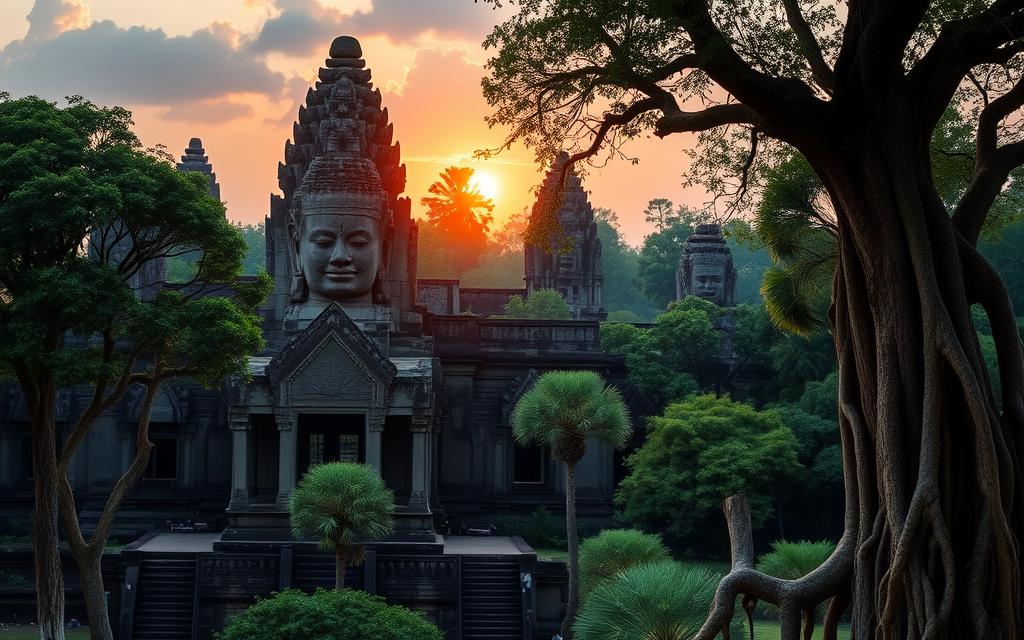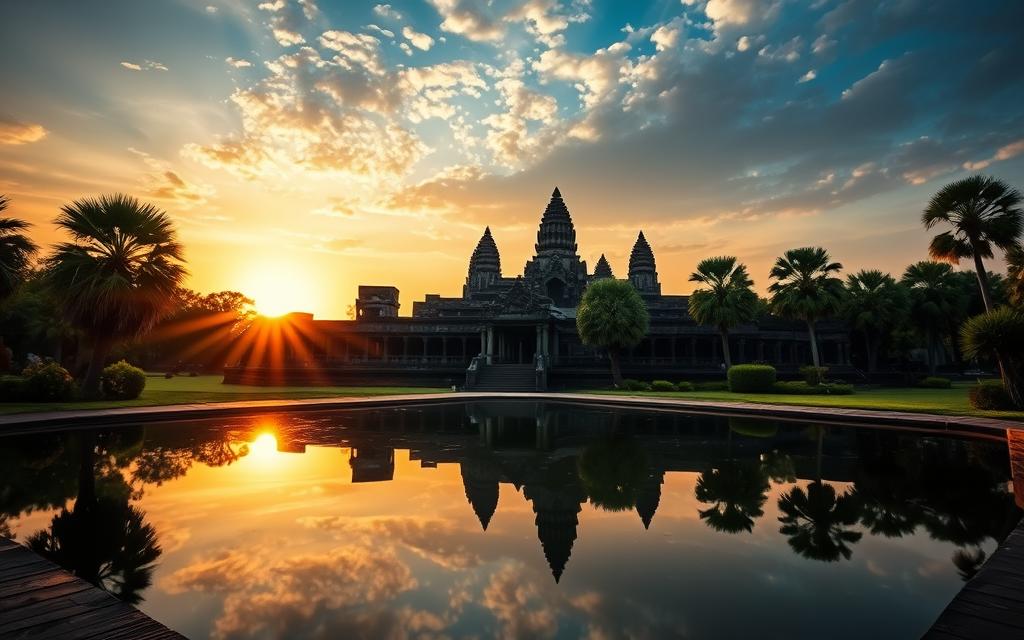Imagine stepping back in time to a place where ancient history meets the green jungle. Welcome to the Angkor Archaeological Park, a huge area that was once the Khmer Empire’s capital. At its center is Angkor Wat, a temple complex known worldwide for its beauty and spiritual importance. But what else can you see in this UNESCO World Heritage Site? Let’s explore the top sights that make Angkor Wat a key destination for those wanting to dive into Cambodia’s culture.
What secrets are hidden in the Angkor Wat complex, waiting for curious travelers to find them? Get ready to be amazed by the tall lotus-shaped towers, detailed bas-reliefs, and the incredible size of this wonder. From the mysterious, tree-covered ruins of Ta Prohm to the stunning, smiling faces of the Bayon Temple, the Angkor Archaeological Park offers a journey that goes beyond time and space.
Unveiling the Architectural Marvel: Angkor Wat
Angkor Wat is the largest religious monument on Earth. It has amazed people for centuries. Built in the 12th century by King Suryavarman II, it spans 162 hectares. It’s a UNESCO World Heritage Site.
Background Information about Angkor Wat
At first, Angkor Wat was a Hindu temple for Vishnu. Later, it became a Buddhist site. Its walls show scenes from Hindu epics and Khmer life. Today, it symbolizes Cambodia’s culture and the Khmer’s architectural skill.
Efforts to save Angkor Wat are ongoing. This ensures visitors can see the sunrise and explore the Angkor Archaeological Park. The park includes Bayon, Ta Prohm, and Angkor Thom.
| Key Facts about Angkor Wat | Details |
|---|---|
| Size | Angkor Wat covers over 400 acres, making it the largest religious monument in the world. |
| Construction | Angkor Wat was built in the 12th century by King Suryavarman II of the Khmer Empire. |
| Religious Significance | The temple was initially dedicated to the Hindu god Vishnu before becoming a Buddhist pilgrimage site. |
| UNESCO World Heritage Site | Angkor Wat was designated a UNESCO World Heritage Site in 1992 for its cultural and historical significance. |
| Conservation Efforts | Ongoing restoration and preservation work aim to protect Angkor Wat for future generations. |
Despite war and natural disasters, Angkor Wat’s beauty and importance remain. It shows the Khmer people’s ingenuity and resilience. As a top tourist spot in Cambodia, it amazes visitors with its stunning architecture and history.
Top Tourist Attractions Angkor Wat, Cambodia
In the Angkor Archaeological Park, many top attractions draw visitors from all over. The city of Angkor Thom and its Bayon Temple show the Khmer Empire’s skill in building. The ruins of Ta Prohm, covered in trees, are famous from “Tomb Raider.”
The temple of Preah Khan is known for its detailed carvings and history. Banteay Srei is famous for its sandstone sculptures. The Tonle Sap Lake, the biggest freshwater lake in Southeast Asia, is a peaceful place to visit.
| Attraction | Highlights | Unique Features |
|---|---|---|
| Angkor Thom | Impressive fortified city, Bayon Temple | Massive stone faces, intricate carvings |
| Ta Prohm | Tree-covered ruins, Tomb Raider filming location | Intertwined roots, crumbling structures |
| Preah Khan | Extensive temple complex, intricate carvings | Labyrinthine layout, historical significance |
| Banteay Srei | Delicate sandstone carvings, pink hue | Exquisite craftsmanship, smaller scale |
| Tonle Sap Lake | Largest freshwater lake in Southeast Asia | Unique floating villages, diverse ecosystems |
Each site gives a special look into the Khmer Empire’s culture and architecture. They are key places to see in the Angkor Archaeological Park.

Exploring the Intricate Carvings and Bas-Reliefs
Angkor Wat in Cambodia is famous for its detailed carvings and bas-reliefs. These artworks show scenes from Hindu epics and historical events. They give us a peek into the rich culture and beliefs of the Khmer Empire.
The Churning of the Ocean of Milk
The Churning of the Ocean of Milk is a famous scene at Angkor Wat. It’s carved in the southern section of the east gallery. This scene shows 88 asuras and 92 devas pulling on a rope to get the elixir of immortality from the sea.
Army of Suryavarman II
The western section of the south gallery has a triumphal battle march of Suryavarman II’s army. The carving shows the king on an elephant, surrounded by soldiers. It shows the Khmer Empire’s military strength.
Heaven and Hell Depictions
The eastern half of the south gallery at Angkor Wat shows the punishments and rewards of the 37 heavens and 32 hells. It gives us a look into the Khmer people’s complex religious beliefs and afterlife concepts.
“The bas-reliefs at Angkor Wat are a true testament to the artistic and cultural legacy of the Khmer Empire, capturing the imagination of visitors from around the world.”
Experiencing the Angkor Archeological Park
Step into the captivating realm of the Angkor Archeological Park. It’s a 250-square-mile complex filled with ancient temples, ruins, and historical wonders. This place is more than just Angkor Wat. It’s a treasure trove of architectural brilliance and cultural heritage.
Explore Angkor Thom, the fortified city that was once the capital. Walk through the mysterious, tree-covered ruins of Ta Prohm. Here, nature and stone blend in a captivating way. Don’t miss Banteay Srei, a temple known for its intricate sandstone carvings and exceptional craftsmanship.
Preah Khan temple offers a glimpse into the Khmer legacy. It shows the religious and spiritual beliefs of the region. Every step through the park takes you back in time, surrounded by the beauty and significance of these landmarks.

Exploring the Angkor Archeological Park is more than just seeing sights. It’s a journey that engages all your senses. From the sounds of birds to the scent of foliage, the park invites you to dive into the timeless essence of Khmer culture. Whether you love history, architecture, or just unique experiences, this park will leave you with unforgettable memories.
“Visiting the Angkor Archeological Park is like stepping into a living, breathing time capsule – a testament to the resilience and ingenuity of the Khmer people.”
Bayon: The Mesmerizing State Temple
In the heart of Angkor Thom, the last Khmer Empire capital, lies the 12th-century Bayon temple. It’s a marvel built by King Jayavarman VII. The temple is famous for its towers and faces that seem to watch in every direction.
Bayon Temple: A Khmer Architectural Wonder
The Bayon Temple boasts 54 Gothic towers and 216 huge smiling faces of Avalokiteshvara. It’s filled with 1.2km of bas-reliefs, featuring over 11,000 figures. The upper level is closed for restoration and will reopen in 2022.
The Khmer empire was split into 54 provinces, matching the temple’s 54 towers. The first level shows life in 12th-century Cambodia. The second level has scenes of battles and the 1177 war that hit Angkor Thom.
The temple’s design shows Jayavarman VII’s vision, even though he started late. It marks a shift from Hinduism to Mahayana Buddhism. This shows Jayavarman VII’s bold vision and symbolism in the temple’s design.
Bayon Temple is at Angkor Thom‘s center. Its faces are said to show Avalokitesvara’s wisdom. Visitors can wander through its passageways, steps, and galleries. They’ll see amazing bas-reliefs and carvings that show the Khmer’s culture and beliefs.
“The Bayon Temple is a stunning example of Khmer architectural prowess, with its multiple towers adorned with serene, enigmatic faces that seem to gaze out in all directions.”
Embracing Khmer Culture and History
Visiting the Angkor Archaeological Park lets you dive into the rich Khmer culture and history. The temples of Angkor Wat, Angkor Thom, and others were more than just buildings. They were the spiritual and political centers of the Khmer Empire for centuries.
Exploring these sites helps you understand and appreciate the Khmer civilization. You’ll see the religious meaning of the temples and learn about everyday life and important events. The Angkor complex offers a unique look into the Khmer people’s cultural heritage.
| Key Facts About Angkor Wat | Values |
|---|---|
| Area of Angkor Wat temple complex | 162.6 hectares (1,626,000 m2; 402 acres) |
| Number of visitors per year | More than 2.5 million |
| Altitude of Angkor Wat | 65 m (213 ft) |
| Year Angkor Wat was designated as a UNESCO World Heritage Site | 1992 |
| Length of the outer wall surrounding Angkor Wat | 3.6 kilometers (2.2 mi) |
The Khmer Culture and Cambodian History in the Angkor Civilization and Angkor Wat amaze visitors worldwide. They offer a deep and immersive experience that goes beyond time.
“Angkor Wat stands as a testament to the ingenuity, artistry, and spiritual devotion of the Khmer people, whose legacy continues to inspire awe and wonder in all who encounter it.”
The Angkor Archaeological Park invites you to explore the heart of Khmer Culture. It’s a journey through the Angkor Civilization‘s captivating history. This experience leaves a lasting impact, showing the enduring spirit of a people whose legacy shapes our world.
Adventure Awaits: Exploring the Angkor Complex
For those looking for adventure, guided cycling tours and helicopter rides are great options. Cycling tours let you see the temples up close and meet locals. Helicopter rides give you a bird’s-eye view, showing the temples’ size and the landscape.
Guided Cycling Tours
Going on a guided cycling tour is exciting. It lets you see the temples and meet locals. You’ll see hidden spots and learn about the area’s history.
Helicopter Rides over Angkor Wat
Helicopter rides over Angkor Wat are unforgettable. They show the temples’ beauty from above. It’s a great way to see the site’s grandeur.
Exploring Angkor by bike or helicopter is an adventure. It lets you dive deep into the area’s culture and history.
| Activity | Cost | Duration | Highlights |
|---|---|---|---|
| Guided Cycling Tour | $20-$30 per person | 2-4 hours | Intimate exploration of temples, interaction with local communities, and unique perspectives on the Angkor complex |
| Helicopter Ride over Angkor Wat | $100-$150 per person | 30-60 minutes | Breathtaking aerial views of the Angkor complex, including the iconic Angkor Wat temple |
“Exploring the Angkor complex on a guided cycling tour is a thrilling way to immerse oneself in the rich cultural and historical tapestry of this remarkable destination.”
Siem Reap: Gateway to Angkor Wat
The city of Siem Reap is the main entry point to the Angkor Archaeological Park. It offers many places to stay, eat, and experience the local culture. Visitors can check out Artisans Angkor, a place that helps keep Khmer crafts alive. They can also visit the lively Psar Chaa (Old Market) for real Cambodian food and crafts.
The Angkor Night Market, near Sivatha Street, is another must-see. It has a wide range of souvenirs, silks, and rice wines.
Siem Reap is full of life and close to the Angkor complex. It’s the best place to start exploring this UNESCO World Heritage Site. You can see the amazing carvings at Angkor Wat or learn about Khmer traditions. Siem Reap is the perfect spot to discover the history and beauty of this place.
Siem Reap is not just about Angkor Wat. It has many temples and cultural spots, each with its own story. You can see the stunning Bayon Temple or the mysterious Ta Phrom. Siem Reap invites you on a journey through Cambodia’s past and present.
Source Links
- https://www.rainforestcruises.com/guides/angkor-wat-what-to-do
- https://globalcastaway.com/visiting-angkor-wat/
- https://nomadgirl.co/first-timers-guide-to-visiting-the-angkor-wat/
- https://medium.com/@angelicdolphin12/angkor-wat-unraveling-cambodias-timeless-marvel-ddb414c0901d
- https://www.mollywozhere.com/angkor-wat-cambodias-architectural-marvel/
- https://www.lonelyplanet.com/cambodia/temples-of-angkor/attractions
- https://cambodiatravel.com/things-to-do-in-angkor-wat/
- https://www.acouplescalling.com/exploring-angkor-wat-cambodias-top-tourist-attraction/
- https://www.lonelyplanet.com/articles/cambodia-famous-temple-angkor-wat-info
- https://velvetescape.com/the-wonders-of-angkor-wat/
- https://www.tourismcambodia.com/attractions/angkor.htm
- https://whc.unesco.org/en/list/668/
- https://www.lonelyplanet.com/cambodia/angkor-thom/attractions/bayon/a/poi-sig/500534/1318768
- https://wanderingcarol.com/bayon-temple-angkor-thom-siem-reap/
- https://en.wikipedia.org/wiki/Angkor_Wat
- https://asiapioneertravel.com/blog/angkor-complex/
- https://medium.com/@hosannacambodiatravel/exploring-the-wonders-of-angkor-wat-your-ultimate-siem-reap-tour-package-c2ab3b51f06a
- https://thatoneadventurecouple.com/best-way-explore-angkor-wat/
- https://www.nishiv.com/all-you-need-to-know-before-visiting-angkor-wat/
- https://themaritimeexplorer.ca/2024/06/25/siem-reap/
- https://www.earthtrekkers.com/angkor-wat-siem-reap/

